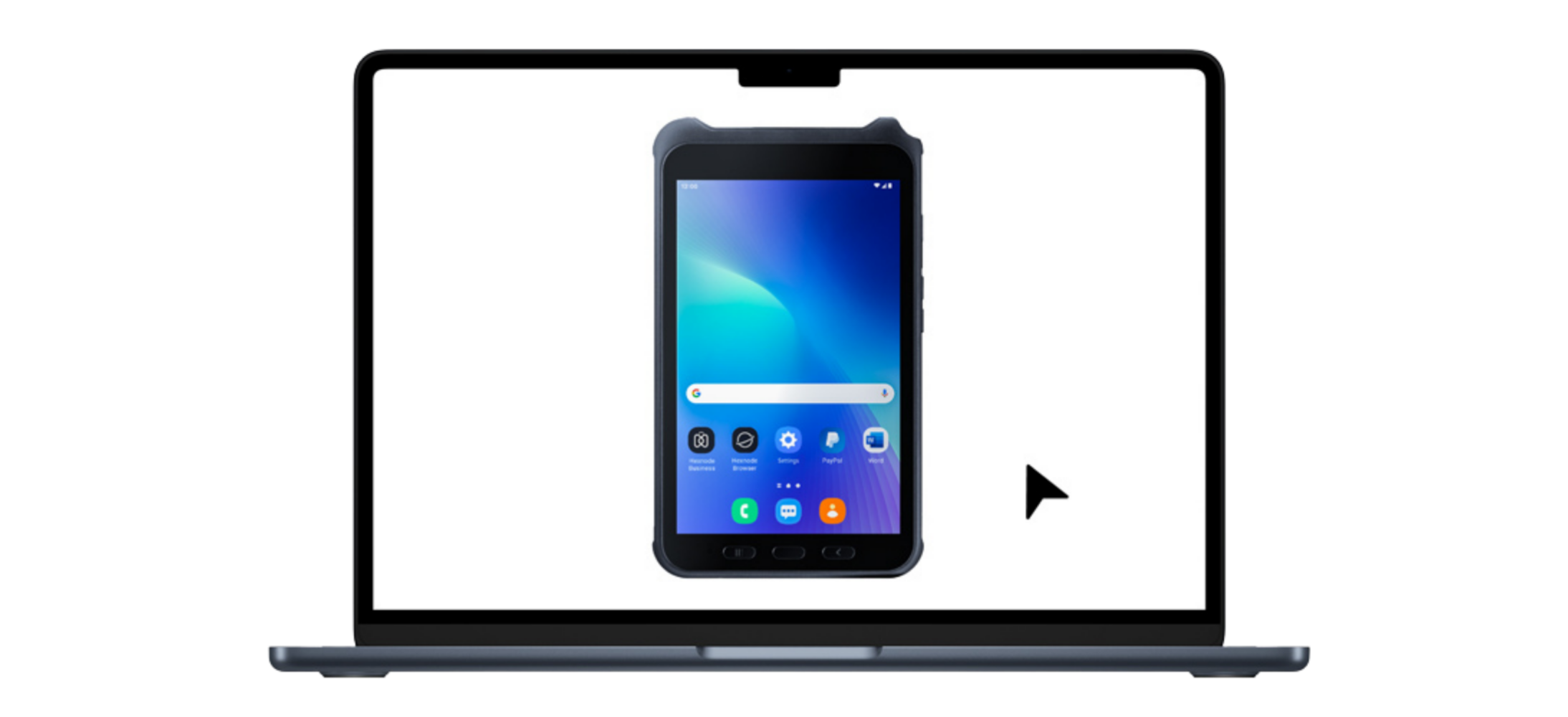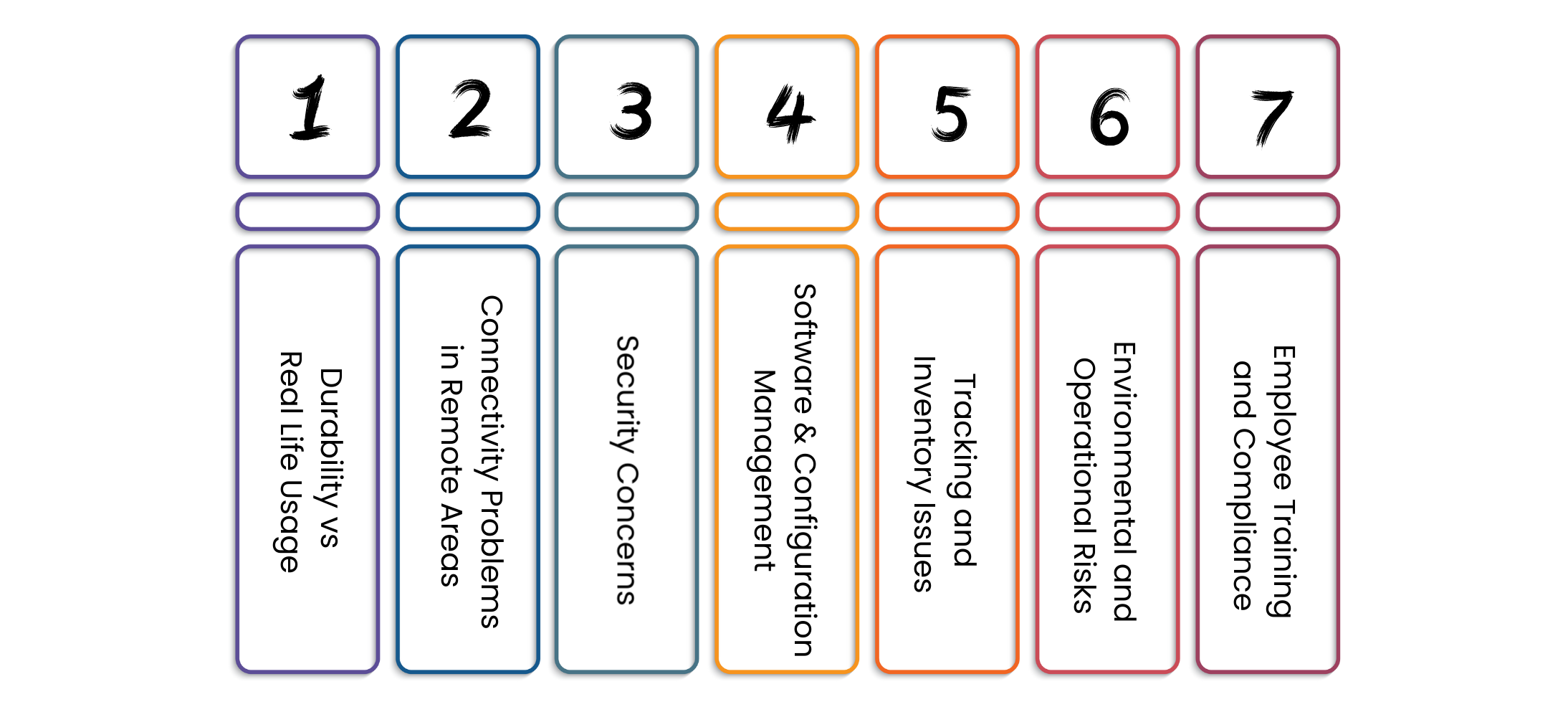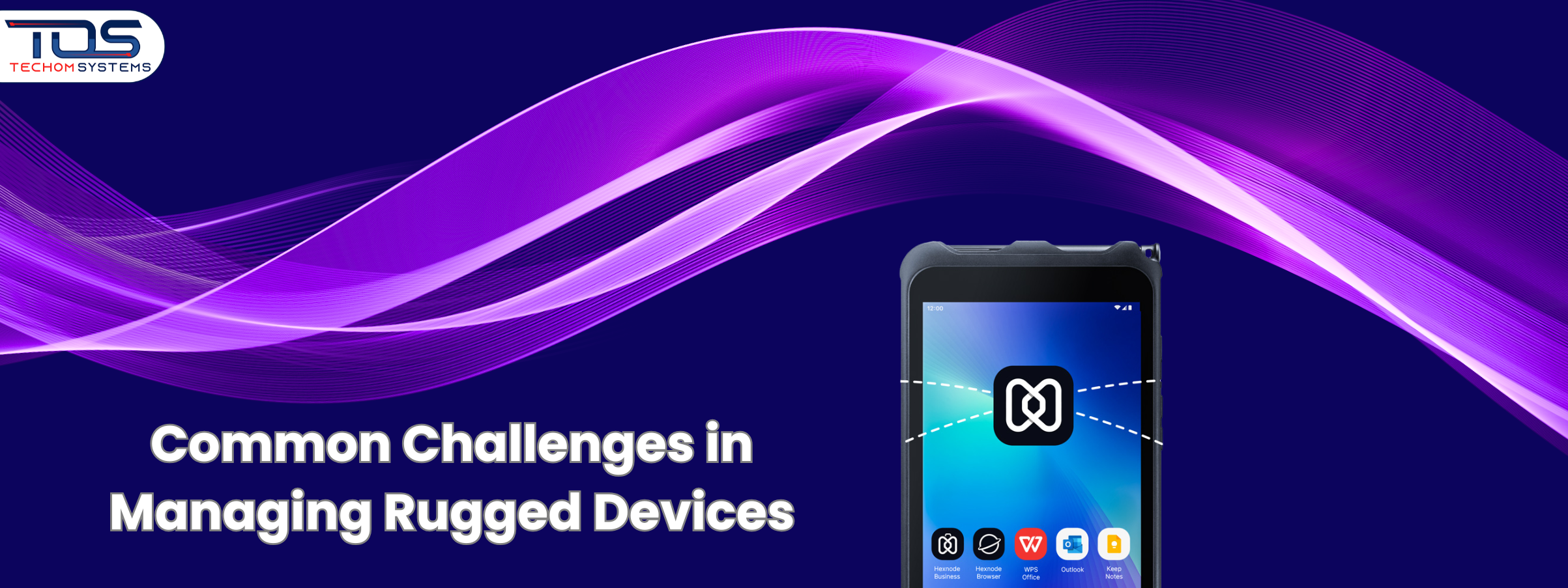Have you ever faced difficulties keeping your devices reliable in tough working conditions? For businesses that depend on industrial equipment and field operations, knowing the common challenges in managing rugged devices is essential. Rugged devices face unique issues like harsh environments, connectivity problems and security threats.
Effective mobile device management for rugged devices helps businesses protect sensitive data, maintain smooth operations and extend device life. In this blog, we will discuss key challenges and share best practices for managing them efficiently.
Ready to overcome the challenges of rugged device management, improve security and maximize the lifespan of your devices? Book a free consultation with TECHOM Systems today and get expert guidance tailored to your business needs.
What Is Rugged Device Management?

Source: Hexnode
Rugged device management is the process of overseeing devices designed for industrial, field or extreme environments. These devices are built to be durable but still need careful monitoring to perform reliably in tough conditions.
Key Functions of Rugged Device Management
- Monitor Performance: Track device health, battery life and functionality to prevent unexpected downtime and ensure smooth workflows
- Secure Data: Protect sensitive information stored on rugged devices, enforce security policies and prevent unauthorized access
- Manage Devices Remotely: Streamline updates, app installations, policy enforcement and troubleshooting without needing physical access
- Boost Productivity: Use mobile device management for rugged devices to keep teams connected, reduce manual IT work and maintain consistent performance
- Compliance and Reporting: Ensure devices meet industry standards and regulations, generate reports for audits and track device usage across teams
- Extend Device Lifespan: Regular monitoring, preventive maintenance and proper configuration help maximize the durability and operational life of rugged devices
Effective rugged device management allows businesses to maintain operations, secure critical data and get the most value from their equipment.
For a deeper understanding of rugged devices, check out our detailed guide on What Is A Rugged Device. This guide explains types, features and use cases to help you manage them better.
Common Challenges in Managing Rugged Devices Management

1. Durability vs Real Life Usage
Rugged devices are marketed as “drop proof” and “weather resistant.” But in reality, even the toughest devices have limits. Some real life situations include:
- On a construction site, a tablet may survive a fall, but repeated drops on concrete can cause the screen to loosen or the battery to malfunction.
- In oil and gas fields, exposure to chemicals or extreme heat can shorten the device’s lifespan.
💡 Pro Insight:
Always match the rugged device’s rating (like MIL STD 810G or IP68) with your industry’s specific environment. Also, use protective accessories like bumpers, covers and screen guards to extend durability.
2. Connectivity Problems in Remote Areas
Connectivity is the lifeline for rugged devices. Whether it is updating delivery routes, syncing medical records or transmitting sensor data without strong connectivity, operations suffer. Here is where businesses struggle:
- Field engineers in remote mining locations often struggle with weak cellular signals.
- Logistics staff may lose Wi Fi access in warehouses with thick concrete walls.
💡 Pro Insight:
Choose devices with multi network support (4G/5G + Wi Fi + satellite backup). Combine this with offline capable apps so data is never lost when the device reconnects. An MDM solution for rugged devices can also help IT teams detect and fix connectivity drops instantly.
3. Security Concerns
Unlike office laptops that stay indoors, rugged devices travel everywhere such as trucks, warehouses, factories, even open fields. This mobility increases the risk of data breaches and theft. Some common risks include:
- If a logistics worker loses a rugged handheld device, customer data could end up in the wrong hands.
- Malware attacks are common when devices connect to unsecured public Wi Fi.
💡 Pro Insight:
Deploy multi layered security:
- Enforce device encryption and multi factor authentication.
- Enable remote lock and wipe to protect lost devices.
- Use enterprise rugged device management tools that ensure compliance across all devices.
4. Software and Configuration Management
Imagine having 200 rugged devices across different locations — all needing the same app update. Without proper management, IT teams will waste time manually updating each device. Worse, if updates are missed, security loopholes can appear. Typical challenges look like this:
- Devices needing the same app update at multiple locations.
- Security loopholes appearing when updates are missed.
💡 Pro Insight:
- Use mobile device management (MDM) to push apps, OS patches and configurations remotely.
- Automate updates during non working hours to avoid downtime.
- Standardize configurations so every rugged device performs consistently.
5. Tracking and Inventory Issues
Many companies struggle to track where their rugged devices are, who is using them and in what condition. The most common problems include:
- Devices going “missing” without accountability.
- Teams hoarding spares while others face shortages.
- Over purchasing because of poor visibility.
💡 Pro Insight:
Adopt centralized rugged device inventory management. Track device location, usage hours, battery health and repair history. This way, you maximize ROI and prevent unnecessary costs.
6. Environmental and Operational Risks
Rugged devices are exposed to extreme environments that normal devices never face. Examples of these risks are:
- High humidity in manufacturing plants damages internal circuits.
- Dust and sand in mining sites clog charging ports and reduce efficiency.
- Vibration from heavy machinery causes hardware loosening over time.
💡 Pro Insight:
Choose devices that meet industrial certifications like ATEX for explosive environments. Combine with regular maintenance schedules and protective enclosures to extend the device’s lifecycle.
7. Employee Training and Compliance
Even the toughest devices will not last long if employees misuse them. Common mistakes include:
- Workers using rugged tablets without protective cases.
- Ignoring mandatory updates because they “take too long.”
- Sharing login credentials, creating compliance risks.
💡 Pro Insight:
- Conduct hands on training sessions on device handling.
- Create easy to follow compliance checklists for workers.
- Use MDM policies that automatically enforce rules (e.g., blocking devices that skip updates).
Why Solving These Challenges Matters
Every challenge above directly impacts business continuity, cost savings and employee productivity. Companies that ignore rugged device management issues face:
- Frequent downtime due to device failures.
- Increased repair and replacement costs.
- Data security risks leading to compliance penalties.
On the other hand, businesses that adopt enterprise rugged device solutions backed by mobile device management (MDM) enjoy:
- Longer device life
- Stronger data security
- Higher employee efficiency
- Lower IT costs
Don’t let rugged device challenges slow down your business. At TECHOM Systems, we provide expert rugged device management solutions that secure, optimize and extend the life of your industrial devices. Book a free consultation with TECHOM Systems today and see how we can transform your device management strategy.
Best Practices To Overcome Rugged Device Management Challenges
Managing rugged devices effectively means tackling the common challenges in managing rugged devices with the right strategies. These best practices not only reduce risks but also improve security, performance and overall mobile device management for rugged devices. To make this practical, businesses should focus on:
1. Regular Device Monitoring and Audits
Regular audits and monitoring help businesses keep track of rugged devices across multiple locations. This ensures that devices are being used correctly, perform well and meeting compliance requirements. Monitoring also helps identify issues early, such as hardware failures or software glitches, before they cause downtime.
2. Using Cloud Based MDM Solutions
Cloud based mobile device management solutions are essential for rugged device management. They allow IT teams to push updates, apply security patches and configure devices remotely, even in remote or industrial locations. This saves time, reduces costs and ensures every rugged device stays up to date without manual intervention.
3. Training Employees on Proper Device Handling
Employee training is one of the most overlooked practices. Rugged devices are designed to be tough but mishandling can still cause damage or performance issues. Training employees in correct usage, safe handling and basic troubleshooting improves device lifespan and reduces repair costs. A trained workforce also uses the devices more efficiently in their day to day tasks.
4. Implementing Secure Authentication and Access Policies
Security is a major concern for rugged devices. Without proper controls, they can become easy targets for unauthorized access and data breaches. Strong authentication methods such as multi factor authentication combined with strict access policies safeguard sensitive data. This ensures that only authorized users can access business information stored on rugged devices.
Following these best practices not only improves rugged device management but also builds a secure and efficient environment for daily operations. organizations that focus on monitoring, remote management, employee training and strong security measures are more likely to avoid costly disruptions and protect their workforce productivity.
Rugged Device Management vs Standard Device Management
When businesses evaluate device strategies, it is important to understand how rugged device management differs from standard device management. This comparison helps decision makers choose the right solution for their industry and environment.
| Aspect | Rugged Device Management | Standard Device Management |
|---|---|---|
| Environment | Built for extreme conditions like construction, mining and logistics | Designed for office and indoor environments |
| Durability | Resistant to drops, dust, water and temperature fluctuations | Limited durability, prone to quick damage |
| Security Needs | Higher risk due to mobility and field usage, requires strong compliance and MDM policies | Lower risk, managed in controlled office networks |
| Connectivity | Must support remote locations with multi network backup options | Usually relies on stable office Wi Fi or LAN |
| Management Complexity | Requires specialized mobile device management for rugged devices | Easier to manage with standard MDM tools |
| Cost Efficiency | Higher upfront investment but longer lifecycle and reduced downtime | Lower upfront cost but frequent replacements increase expenses |
By comparing rugged device management with standard device management, businesses can clearly see why rugged devices require specialized solutions. Understanding these differences ensures better planning, reduced risks and stronger ROI.
Future of Rugged Device Management
The future of rugged device management looks promising as industries continue to adopt advanced mobility solutions. With increasing reliance on field operations, businesses are seeking smarter ways to overcome common challenges in managing rugged devices. To better understand what lies ahead, let’s look at the major trends shaping rugged device management:
- AI and Predictive Analytics: Rugged device management will use artificial intelligence to predict failures, monitor device health and automate preventive actions before downtime occurs.
- 5G and Enhanced Connectivity: Faster and more reliable 5G networks will solve many connectivity issues in remote or industrial locations, ensuring real time data flow and smoother operations.
- Cloud Driven Management: Cloud based mobile device management for rugged devices will dominate, enabling centralized updates, scalability and seamless integration across industries.
- Stronger Security Frameworks: With rising cyber threats, rugged device management will focus heavily on encryption, biometric authentication and compliance ready policies.
- Integration with IoT Ecosystems: Rugged devices will increasingly connect with IoT sensors, enabling industries to manage equipment, assets and field staff under one unified platform.
The evolution of rugged device management ensures that businesses will not only reduce risks but also improve productivity, extend device life and future proof their operations.
Businesses that embrace these changes early will stay ahead. Contact TECHOM Systems to explore how we can help you prepare for the future.
If You Want To Learn More About Hexnode UEM Solutions Then Click Here…
Frequently Asked Questions
#1: What Are The Common Challenges In IoT Device Management And Maintenance?
Ans: The common challenges in IoT device management and maintenance include data security, connectivity issues, device scalability and frequent updates, making it difficult for businesses to maintain efficiency and control across large scale deployments.
#2: What Is Rugged Device Management?
Ans: Rugged device management is the process of monitoring, securing and controlling durable devices in tough environments. It helps businesses address the common challenges in managing rugged devices while ensuring productivity, reliability and data protection.
#3: What Are Rugged Devices In Construction Industry?
Ans: Rugged devices in the construction industry include tough tablets, handhelds and laptops designed to resist dust, water, shocks and extreme weather, ensuring dependable performance and smooth communication on demanding construction sites.
#4: What Are Rugged Devices?
Ans: Rugged devices are durable laptops, tablets and smartphones built to withstand harsh conditions. They are used in industries like construction, logistics and manufacturing, offering reliability and performance where standard consumer devices fail.
Final Thoughts
In this blog, we explored the common challenges in managing rugged devices, such as security risks, downtime and scalability issues. We also discussed how best practices and the right rugged device management solutions can overcome these challenges. The key takeaway is that by prioritizing security, efficiency and proper planning, businesses can ensure rugged devices deliver peak performance and support long term growth.
Ready to take the next step? Contact TECHOM Systems today and book a free consultation to find the best rugged device management solution for your business.
Paige’s 12+ years in tech, cloud solutions and AI innovation have shaped her into a translator of complexity into clarity. She specializes in turning technical strategies and unstructured ideas into actionable, understandable plans for teams and stakeholders. Paige thrives on creating content, workflows and processes that make IT systems accessible, while maintaining accuracy and strategic focus. Her calm, thoughtful approach ensures projects stay on track and teams feel supported, bridging gaps between technology and people. Paige believes clarity in technology is the first step toward meaningful business outcomes.







